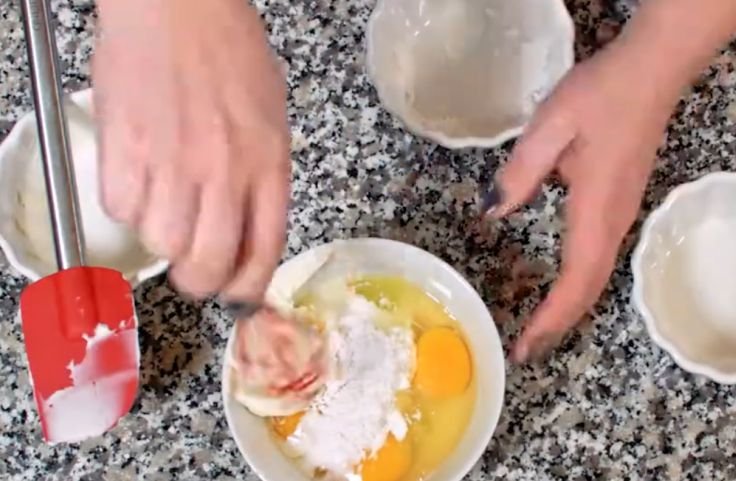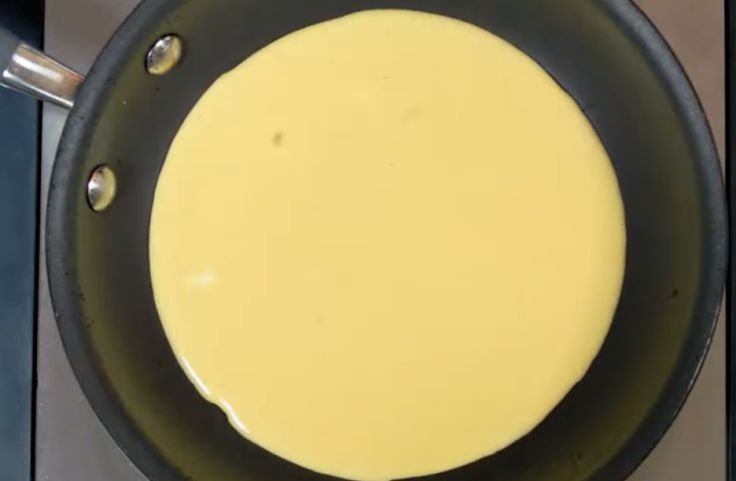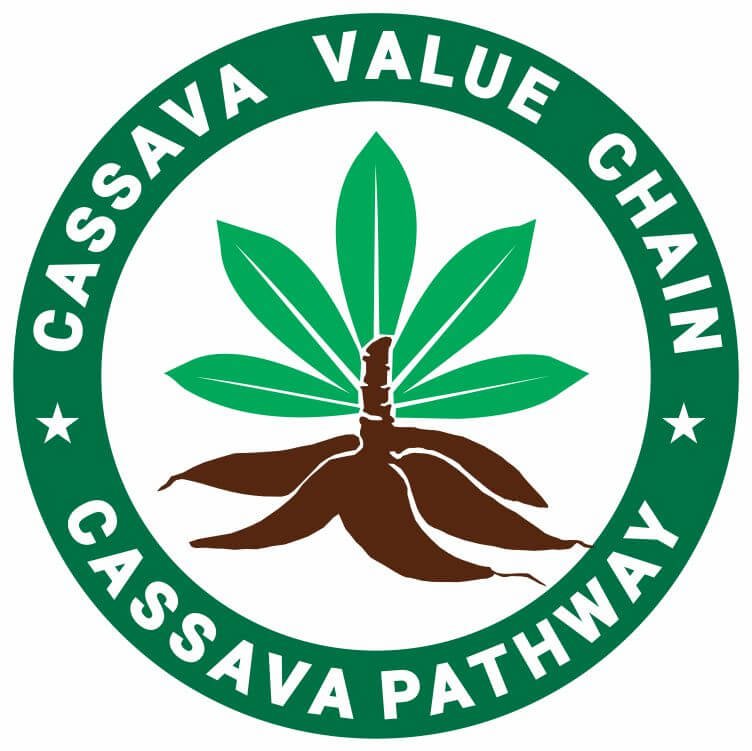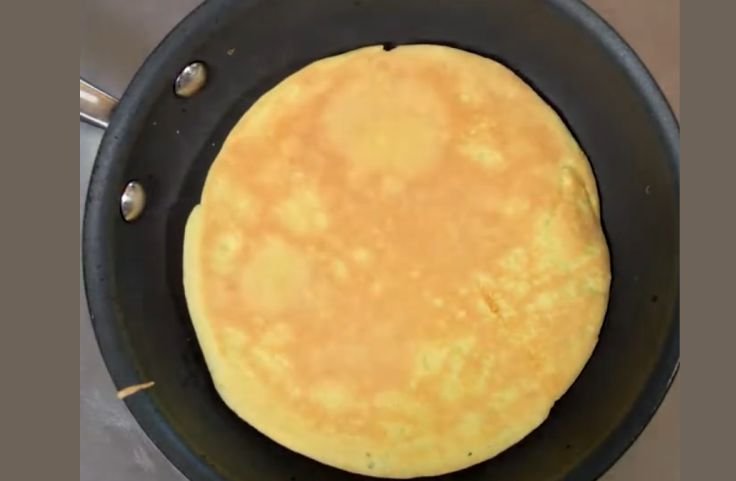Tapioca pancakes are soft, chewy, and gluten-free, perfect when you need something quick and satisfying. With just a few pantry staples, you can whip them up in minutes, no flour needed.
If you’ve got tapioca flour in your pantry, you’re already halfway there.
Unlike cassava flour, tapioca flour gives your pancakes that smooth, chewy bite you didn’t know you were missing.
Popular across cultures, from Brazilian kitchens to Southeast Asian street food stalls, tapioca pancakes are more than just a gluten-free swap.
You can enjoy them plain, with a bit of butter, or fill them with cheese, fruit, or anything else you love.
The texture is soft and stretchy, making every bite feel like comfort. They work well for paleo diets, too.
No gluten. No complicated steps. Just a satisfying pancake that’s ready in minutes and fits into your lifestyle.
Give it a try, it might become part of your regular breakfast rotation.
Related: Tapioca Snacks: Tasty, Chewy, and Perfect for Every Craving
Table of Contents
- What Are Tapioca Pancakes?
- Tapioca Flour vs Cassava Flour in Pancakes
- Ingredients for Basic Tapioca Pancakes
- How to Make Tapioca Pancakes
- Texture and Taste Profile of Tapioca Pancakes
- Flavor and Topping Variations for Tapioca Pancakes
- Tapioca Pancakes Around the World
- Storage and Reheating Tips
- Conclusion
- Frequently Asked Questions About Tapioca Pancakes
What Are Tapioca Pancakes?
Tapioca pancakes are gluten-free pancakes made using tapioca flour extracted from the root of the cassava crop. These pancakes can vary in thickness and texture, ranging from thin and flexible like crepes to thicker and chewier forms.
They are naturally grain-free and often enjoyed by people with gluten sensitivities.
Known for their soft, elastic bite, tapioca pancakes are popular in South American and Southeast Asian cuisines.
They can be served plain, filled with cheese or vegetables, or topped with sweet or savory ingredients.
Tapioca Flour vs Cassava Flour in Pancakes
Tapioca flour and cassava flour both come from the cassava root but produce very different pancake results.
Tapioca flour is the starch extracted from the root, giving pancakes a light, chewy texture ideal for delicate, gluten-free versions.
In contrast, cassava flour is made from the whole root, retaining fiber and nutrients, resulting in denser, bread-like pancakes with a heartier feel.
The choice between the two affects both taste and texture; tapioca offers airy softness, while cassava adds substance.
Understanding their differences helps you choose the right flour for your desired pancake experience.
Related Posts
Ultimate Guide To Tapioca Pearls
Tapioca Snacks You Never Knew You Could Enjoy
Healthy Tapioca Recipes to Try
Tapioca Waffles For Savory Dishes
Can Diabetics Eat Tapioca Pudding?
What Are Tapioca Dumplings, and How Do You Make Them?
Ingredients for Basic Tapioca Pancakes

You only need a few simple ingredients to make soft and chewy tapioca pancakes at home.
Each one has a purpose, from giving structure to adding flavor, so pick what suits your taste and dietary needs.
Tapioca Flour: Your pancake’s chewy, gluten-free base
Tapioca flour is the key to getting that soft, chewy bite. It’s made from the starch of the cassava root and works well in gluten-free pancake recipes.
It creates a light texture and blends easily with other ingredients.
Eggs: For structure, moisture, and binding
Eggs hold everything together and add moisture to the batter. They also help the pancakes set well while cooking.
If you don’t eat eggs, use flaxseed meal or a trusted egg substitute that gives a similar effect.
Milk or Plant-Based Milk: Liquid to mix the batter
You can use regular milk for a richer taste or go with almond, oat, or coconut milk for a dairy-free option.
The liquid helps hydrate the flour and gives the batter the right pourable consistency.
Oil or Melted Butter: For flavor and cooking ease
Adding oil or butter makes your batter smooth and your pancakes flavorful. It also helps them cook evenly without sticking to the pan.
Use neutral oil or your favorite butter, depending on your flavor preference.
Salt and Sugar: To season and sweeten the mix
Salt sharpens the flavor of your pancakes, even in small amounts. If you want a slightly sweet taste, add sugar.
You can skip the sugar if you plan to serve your pancakes with savory toppings.
Baking Powder: For a light, fluffy finish
Use a little baking powder to help your pancakes puff slightly and turn out soft.
It’s not required, but it’s a helpful boost if you like a bit of lift in your gluten-free tapioca pancakes.
Related: How to Make Tapioca Sabudana
How to Make Tapioca Pancakes

Tapioca pancakes are naturally gluten-free and easy to prepare. You only need a few ingredients and a non-stick pan.
Follow this step-by-step guide to create chewy or fluffy pancakes based on how you like them.
Mix the dry base: Combine tapioca flour and salt for an even blend
Start by adding tapioca flour and a pinch of salt into a mixing bowl. Stir them well so the salt doesn’t clump or sit in one spot while cooking.
If you like a hint of sweetness, toss in a little sugar. Want some aroma? Try vanilla powder or cinnamon.
Mixing the dry ingredients evenly at this stage sets the tone for smooth, well-balanced pancakes later on.
Add the liquid: Pour water slowly to reach a smooth batter
Gradually pour water into the dry mix while stirring nonstop. You don’t want lumps. The batter should flow easily but not be too watery.
A slightly thinner consistency than regular pancake batter works best for tapioca. If you want them fluffier, add an egg now.
The egg helps bind the batter and gives it more body when cooked. Keep mixing until everything feels smooth and fluid.
Prepare your pan: Heat it and test with a small drop of batter
Use a non-stick pan and place it over medium heat. Give it a minute or two. To check if it’s hot enough, drop a small spoonful of batter.
If it sizzles gently, you’re good to go. No need for oil unless your pan sticks.
Having the right temperature helps your pancakes cook evenly and avoids burning.
If it’s too hot, turn down the heat a little and let the surface cool slightly.
Pour the batter: Use a ladle to spread it into a round pancake
Scoop some batter with a ladle and pour it right in the center of the pan. Gently move the pan in a circle to spread the batter evenly.
If you like thinner pancakes, tilt the pan quickly. For thicker ones, let the batter settle in place.
Don’t rush this part. Let the shape form naturally. The pancake will start to set on the bottom after just a minute or so.
Related: How to Make Tapioca Sabudana
Cook and flip: Watch for bubbles and lifted edges before turning
Let the pancake cook undisturbed. You’ll start to see bubbles on the surface, and the edges may curl up slightly.
That’s your signal to flip it. Use a spatula and turn it over carefully. The second side needs less time to cook, usually about a minute.
Once both sides look lightly golden, remove it from the pan and keep it warm while you make the rest.
Serve and enjoy: Top with fruits, syrups, or savory fillings
Now your pancakes are ready. Stack them or serve one at a time with toppings you enjoy.
Fresh fruit, honey, peanut butter, or even a fried egg works well. The chewy base pairs well with both sweet and savory flavors.
Serve them warm and fresh for the best bite. You can even fold them like wraps or roll them with fillings for a fun twist on breakfast or brunch.
Related: Tapioca Bubble Tea: The Boba’s Chewy Star
Texture and Taste Profile of Tapioca Pancakes
Tapioca pancakes give you a chewy, light bite with a neutral flavor that blends beautifully with your favorite toppings.
They’re a gluten-free option you’ll want to keep making.
Chewy and Tender with Every Bite
When you cook tapioca pancakes, they come out soft and chewy rather than fluffy.
This texture comes from tapioca flour, which holds moisture well and gives pancakes an elastic feel.
If you’re used to wheat pancakes, the texture may surprise you, in a good way.
You get a bite that’s stretchy but light, making it great for layering with fruits, syrups, or savory fillings.
Mild Flavor That Lets Toppings Shine
Tapioca pancakes don’t have a strong taste. That’s what makes them perfect if you love experimenting with toppings.
You can go sweet with honey and berries or savory with eggs and cheese.
Since the base doesn’t compete for attention, the flavor of your toppings comes through clearly.
You’re in full control of how each bite tastes, and that makes them fun to serve.
Golden Edges and Translucent Centers
A well-cooked tapioca pancake has golden edges and a slightly see-through center, especially when made thin.
This look is more than just pretty; it’s a sign of proper cooking. The crispy edges contrast with the tender middle, giving you a mix of textures.
You’ll love how it looks on the plate and feels in your mouth. Serve it hot, and watch how fast it disappears.
Related: Tapioca Bubble Tea Recipe
Flavor and Topping Variations for Tapioca Pancakes
Tapioca pancakes are your blank canvas. You can go sweet or savory, simple or bold.
What you add is totally up to your taste and your mood.
Sweet with Syrup and Fresh Fruit
If you love starting your day on a sweet note, top your pancakes with maple syrup or honey.
Then slice up bananas, strawberries, or apples and scatter them over the top.
The chewy texture of the tapioca holds up beautifully to the syrup and the soft bite of fresh fruit.
You get sweetness, fiber, and a satisfying chew in every forkful.
Nut Butter and Banana Combo
Spread a spoonful of almond or peanut butter on warm pancakes, and layer banana slices over it.
The warmth of the pancakes melts the nut butter slightly, giving you a rich, creamy layer that’s packed with protein.
Bananas add a mellow sweetness that ties everything together. This combo gives you energy without weighing you down.
Eggs and Cheese for a Savory Twist
Crack a poached or scrambled egg over your tapioca pancake, and top it with melted cheese.
The pancake’s mild flavor lets the richness of the egg and cheese shine through.
It’s a satisfying, high-protein option that works well for breakfast or dinner. Add black pepper or chili flakes if you like a little kick.
Avocado and Turkey Layers
Sliced avocado brings creaminess, while lean turkey adds depth and a good dose of protein.
Stack them up on your tapioca pancake for a clean, savory meal that keeps you full longer.
Add a squeeze of lime or a sprinkle of sea salt for balance. It’s a light but hearty option that works any time of day.
Cheese in the Batter
Grate your favorite cheese straight into the batter before cooking.
As the pancake cooks, the cheese melts and browns, giving you a slightly crisp, savory edge with every bite.
You don’t need extra toppings here, just a warm stack of cheesy goodness that stands on its own. Pair it with a side salad or soup for a full meal.
Mashed Banana and Cinnamon Mix
Mash a ripe banana and stir it into your batter. Then add a light shake of cinnamon before cooking.
The banana sweetens the pancake naturally, and the cinnamon adds warmth.
You get soft, fragrant pancakes with no need for added sugar. Top with extra banana slices or a small spoonful of yogurt if you like.
Fresh Herbs and Chives
If you want a fresh, savory take, mix chopped chives, cilantro, or parsley into your batter.
The herbs brighten up the flavor and pair well with toppings like eggs, cheese, or even sautéed mushrooms.
Each bite feels light, fresh, and satisfying without being heavy. Great for brunch or a midday snack.
Related: Step-by-Step Guide to Cooking Tapioca Dumplings
Tapioca Pancakes Around the World
You taste traditions with tapioca pancakes from Brazil to Thailand. You see, cassava flour transforms into soft pancakes that carry local history, sweet or savory flavors in every bite, anywhere.
Brazilian Beiju de Tapioca:
You find beiju de tapioca in Brazil, cooking tapioca flour with water until it forms a soft crepe on a hot pan.
You spread fillings like shredded coconut mixed with sugar for a sweet bite or grated cheese and chopped vegetables for savory.
This flexible pancake becomes a favorite time of day. It’s simple dough respects the cassava plant traditions while inviting you to try new flavor combos each time.
Thai Kanom Tapioca:
You see, kanom tapioca is sold from street stalls across Thailand. Vendors mix tapioca pearls with coconut milk and sugar.
They spread the batter on a grill until the pancake holds a chewy bite.
You taste its mild sweetness, warm from the heat, and feel a hint of richness from the coconut.
Served fresh, these snacks reflect local life and tradition, inviting you to enjoy a simple treat on the move.
Paleo and Grain Free Pancake Fusion:
You join paleo and grain-free cooks turning to tapioca pancakes as a gluten-free substitute.
You mix cassava starch with eggs and water or milk to form batter you cook into thin cakes.
These pancakes become wraps for roasted vegetables and sliced meats or for sweet bowls with berries and yogurt.
You enjoy a flexible menu that fits diet needs and brings a taste of tradition into modern plates.
Storage and Reheating Tips
Tapioca pancakes taste best fresh, but with proper storage, you can still enjoy leftovers.
Store them in the fridge for up to a few days in an airtight container or wrapped in plastic to keep them soft.
For longer storage, freeze them flat, separate each with parchment paper, and seal in a freezer-safe bag for up to three months.
To reheat, use a non-stick skillet over low heat for 1–2 minutes per side to keep their texture.
You can also microwave them for 20–30 seconds, covered with a damp paper towel to avoid drying out.
Conclusion
Tapioca pancakes are soft, chewy, and ready in minutes, perfect when you need something quick, tasty, and gluten-free.
With simple ingredients and easy steps, you can cook a batch for breakfast, snacks, or even dinner.
You don’t need special tools or fancy skills. Just mix, pour, flip, and serve.
Whether you go sweet or savory, tapioca pancakes let you get creative with toppings and fillings.
They store well, reheat easily, and work for most diets, including gluten-free and paleo.
If you’ve got tapioca flour in your kitchen, you’ve already got what you need. Give it a try and make it your go-to pancake.
Frequently Asked Questions About Tapioca Pancakes
Are tapioca pancakes gluten-free?
Yes, tapioca pancakes are naturally gluten-free since they’re made from tapioca flour, which contains no wheat or grains. They’re safe for gluten-sensitive or celiac diets.
Can I make tapioca pancakes without eggs?
Yes, you can swap eggs with mashed banana, flaxseed meal, or store-bought egg replacers. These bind the batter and give a similar chewy texture when cooked.
How do I keep tapioca pancakes from sticking to the pan?
Use a well-heated non-stick pan. You don’t need oil unless your pan sticks. Let the pan preheat fully before pouring in the batter.
What toppings go best with tapioca pancakes?
Top them with fruits, honey, or nut butter for sweet versions. For savory options, try eggs, cheese, herbs, or avocado for a rich and satisfying meal.
References

Chimeremeze Emeh is a writer and researcher passionate about Africa’s most transformative root crop—cassava. Through his work at cassavavaluechain.com, he explores the entire cassava industry, from cultivation and processing to its diverse applications in food, health, and industrial use.
He also writes for palmoilpalm.com, where he shares his extensive experience and deep-rooted knowledge of palm oil, covering red palm oil, palm kernel oil, and refined products. His work there reflects his lifelong connection to agriculture and his commitment to promoting sustainable value chains in Africa.
Driven by curiosity and purpose, Chimeremeze aims to shed light on how cassava continues to empower communities, strengthen food systems, and link traditional farming wisdom with modern innovation.

